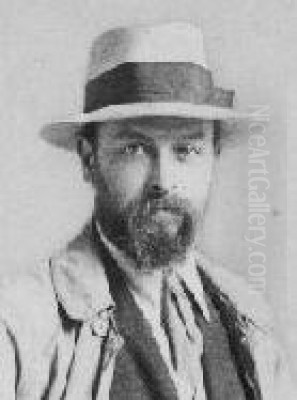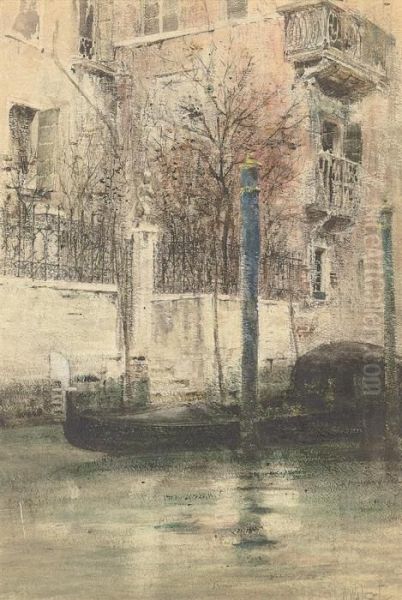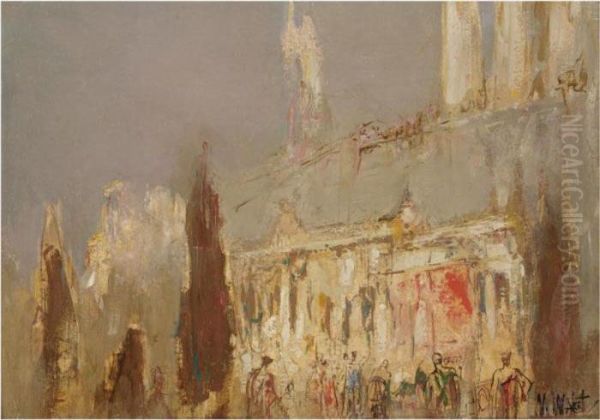
William Walcot (1874-1943) stands as a significant figure in early 20th-century British art, celebrated primarily for his evocative depictions of architecture through etching, drypoint, and watercolour. Born into a world straddling different cultures, his unique perspective and remarkable technical skill allowed him to capture not just the form, but the very atmosphere and historical resonance of buildings and cityscapes, both ancient and modern. His work bridges the gap between precise architectural rendering and expressive fine art, leaving a lasting legacy in the realm of printmaking and architectural illustration.
A Cosmopolitan Beginning: Early Life and Education
Born Vasilii Ivanovich Valkot in 1874 near Odessa, in the Russian Empire (now Ukraine), Walcot's heritage was a blend of Scottish and Russian roots. This mixed background perhaps contributed to his peripatetic early life, which saw him spend time in Western Europe and South Africa before returning to Russia for his formal education. His artistic inclinations led him to the prestigious Imperial Academy of Arts in Saint Petersburg, where he studied architecture under the influential professor Leon Benois. This architectural training provided a crucial foundation for his later artistic career.
Seeking broader horizons, Walcot further honed his artistic skills in Paris, immersing himself in the vibrant art scene of the French capital. His time in Russia, however, left a tangible mark. While working in Moscow, possibly before his move to London, he contributed designs to the famous Metropol Hotel, a landmark of the Russian Style Moderne (Art Nouveau). Notably, his design for a distinctive "Lady Head keystone ornament" became an iconic motif associated with this building and the broader movement in Russia, showcasing his early talent for decorative architectural elements.
Establishing a Reputation in London
Around 1906, Walcot made the pivotal decision to move to London, a city that would become the primary stage for his mature artistic career. Initially, he found employment as a draughtsman for the architect Eustace Frere. This position provided practical experience within the British architectural world. However, Walcot's talent and ambition soon led him to establish himself as a freelance architectural perspectivist.

His skills were quickly recognized, and he began producing presentation drawings for many prominent architects of the day. His ability to translate architectural plans into compelling, atmospheric visuals made his work highly sought after. Simultaneously, he pursued his own fine art, creating watercolours and etchings that explored architectural themes. He began exhibiting his work, notably at the Royal Academy, bringing his unique vision to a wider audience and solidifying his reputation within the London art scene.
The Architectural Vision: Style and Technique
Walcot's artistic style is characterized by its focus on architecture, yet it transcends mere technical rendering. He possessed an extraordinary ability to capture the spirit and mood of a place, often employing techniques reminiscent of Impressionism, particularly in his handling of light and atmosphere. While meticulously grounded in architectural accuracy, his works feel alive, imbued with a sense of history, weather, and human presence, even when figures are small or absent.
He was a master of multiple media. His etchings and drypoints are perhaps his most celebrated works, demonstrating exquisite control over line and tone to convey complex architectural forms and textures. He often combined these techniques. His watercolours are equally distinctive, marked by fluid washes, sometimes combined with pastel or pencil, creating luminous and often dramatic effects. His draughtsmanship was exceptional, allowing him to suggest intricate detail without laborious precision, maintaining a sense of spontaneity and artistic freedom.
Walcot and the Etching Revival
William Walcot emerged during the height of the British Etching Revival, a period from the late 19th century into the early 20th century that saw a resurgence of interest in etching as a fine art form. He stands alongside other major figures of this movement, such as the Scottish masters Muirhead Bone and James McBey, the Welsh artist Sir Frank Brangwyn, and the Scot D.Y. Cameron. Each had their own distinct approach: Bone was known for his meticulous detail and topographical accuracy, McBey for his fluid, almost calligraphic line and atmospheric effects, Brangwyn for his bold compositions and dramatic scale, and Cameron for his evocative landscapes and architectural subjects imbued with romanticism.

Walcot carved his own niche within this talented group. While sharing an interest in architectural subjects with Cameron and Bone, Walcot's style was often more painterly and impressionistic in feel than Bone's, focusing less on absolute topographical fact and more on the overall visual impact and historical aura. Compared to Brangwyn's often monumental and vigorously worked plates, Walcot's touch was generally lighter, though equally adept at conveying scale and grandeur. He drew inspiration from earlier masters of architectural etching, like the Swedish-born Axel Haig, but developed a distinctly personal and modern sensibility.
Evoking Worlds Past and Present: Subjects and Themes
Walcot's subject matter was diverse, yet consistently centered around the built environment. He held a deep fascination with the classical world, producing numerous etchings and watercolours that imaginatively reconstructed scenes from ancient Rome, Greece, and Egypt. These were not dry archaeological studies but vibrant attempts to visualize the life and grandeur of antiquity, often populated with figures that brought the scenes to life. His depictions of the Roman Forum, triumphal arches, and ancient temples are among his most iconic works.
Alongside these historical reconstructions, Walcot was a keen observer of the contemporary world. He created memorable views of London, capturing the bustling energy of the city, the majesty of its landmarks like the Bank of England and the Royal Exchange, and the atmospheric charm of the River Thames. He travelled widely, and his artistic journeys resulted in captivating series depicting the canals and palaces of Venice, the historic streets of Naples, and views of other European cities. His work often juxtaposes the monumental scale of architecture with the transient life flowing around it.
Masterpieces in Line and Wash: Representative Works
Several works stand out as representative of Walcot's skill and vision. His London Set, including etchings like Bank with the Royal Exchange, exemplifies his ability to capture the grandeur and activity of the modern metropolis. These works showcase his dynamic compositions and his skill in rendering complex architectural details within an atmospheric setting.
His depictions of Italy were particularly successful. The Piazza San Marco, Venice, is a quintessential Walcot piece, conveying the vastness of the square and the richness of its surrounding architecture through fluid lines and suggestive shading. Similarly, Arc San Carlo, Naples, demonstrates his mastery in portraying the interplay of light and shadow on historic structures, creating a powerful sense of place. Beyond specific titles, his series reconstructing ancient Roman life and his atmospheric views along the Thames remain highly regarded. The aforementioned "Lady Head" keystone from the Metropol Hotel in Moscow remains a unique, early example of his contribution to architectural design itself.
The Height of Acclaim: Recognition and Peers

The 1920s and 1930s marked the zenith of William Walcot's fame and success. His work was widely exhibited and collected, and he was recognized by major artistic institutions. He was elected an Associate of the Royal Society of Painter-Etchers and Engravers (ARE, later RE) and also became a member of the Royal Society of British Artists (RBA). His standing within the architectural profession was confirmed by his election as a Fellow of the Royal Institute of British Architects (RIBA), where he also served for a time, contributing his expertise perhaps in a role akin to an Assistant Secretary.
During this period, he was widely regarded as one of London's foremost architectural artists. His only real rival in terms of popularity for perspective drawings was Cyril Farey, another highly skilled architectural illustrator. While their styles differed – Farey's often being more precise and pristine – both artists dominated the field, frequently exhibiting alongside each other at the Royal Academy. Walcot also collaborated with, or produced perspectives for, some of the leading architects of the era, including giants like Sir Edwin Lutyens, Sir Herbert Baker, Sir Aston Webb, and Sir Reginald Blomfield, translating their designs into compelling visualisations.
Final Years and Enduring Legacy
The outbreak of the Second World War inevitably impacted Walcot's career. The demand for architectural perspectives likely decreased, and the general turmoil of the war years seems to have led to a reduction in his artistic output. He passed away in Hurstpierpoint, Sussex, in 1943.
Despite the quieter end to his career, William Walcot left behind a rich and distinctive body of work. He remains celebrated as one of the outstanding British etchers of the 20th century and a master of architectural representation. His unique ability to blend detailed observation with an impressionistic sensibility, capturing the atmosphere and historical weight of buildings and cities, sets his work apart. He successfully navigated the worlds of architecture and fine art, leaving a legacy that continues to be appreciated for its technical brilliance and evocative power.
Conclusion
William Walcot's contribution to British art lies in his unique synthesis of architectural understanding and artistic expression. Born in Russia and educated across Europe, he brought a cosmopolitan perspective to his depictions of the world's great cities and ancient monuments. As a leading figure in the Etching Revival and a sought-after architectural illustrator, he mastered multiple techniques to create works that were both informative and deeply atmospheric. His etchings and watercolours do more than just record buildings; they evoke moods, suggest histories, and capture the enduring power of architecture, securing his place as a significant artist of his time.